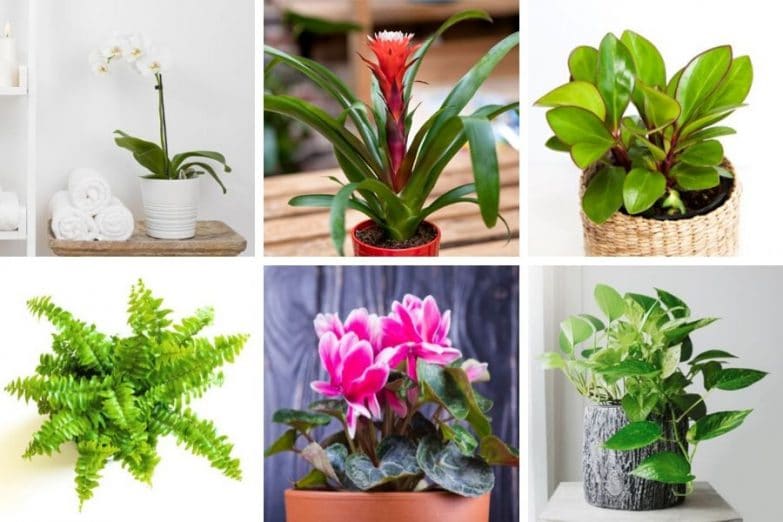Although not the first place you might think of growing houseplants, the bathroom can create perfect conditions for a range of indoor plants. Not only will your plants thrive, but they can improve the aesthetics of your bathroom, creating a luxurious and relaxing environment. This article covers 23 of the best bathroom plants that will suit the conditions of your bathroom and look great too.
So what are the best bathroom plants? Look for plants that thrive in low-light and high-humidity, and can tolerate fluctuations in temperature. Upon first thought, this may seem like a tall request to fill but there are many to choose from.
23 Of The Best Bathroom Plants
This list of 23 best bathroom plants covers a wide variety of types, ranging from those with succulent qualities to plants that grow long, trailing vines, and even one that is carnivorous! They can be set on windowsills, scattered around the edge of a large soaking tub, or even hung in the shower to take advantage of high-humidity levels.
Phalaenopsis Orchids
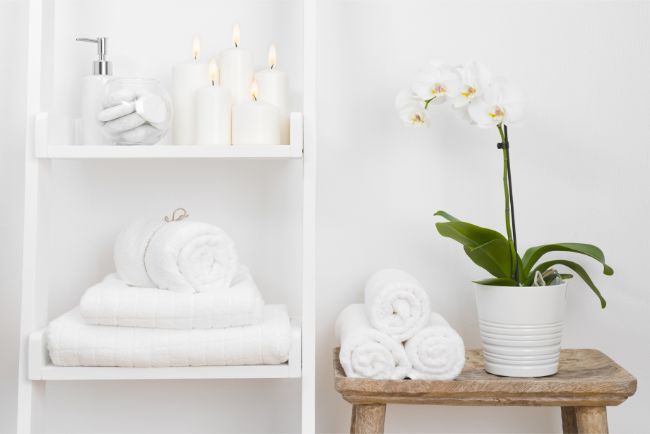
Many people have the belief that orchids are tricky plants to grow indoors, and this is untrue for many varieties you can purchase at your local nursery. Phalaenopsis orchids are actually quite tough and hardy, adapting to a variety of growing conditions. Their stunning appearance and colors add a bright accent to bathrooms.
Unlike other houseplants, orchids are not grown in potting soil but instead are planted in substrates like bark chips, stones, or other loose material to provide exceptional drainage. Orchids prefer to be kept on the drier side and need plenty of air in the root zone, so avoid overwatering.
Read more about phalaenopsis orchid care in this article.
Bromeliads (Bromeliaceae sp.)
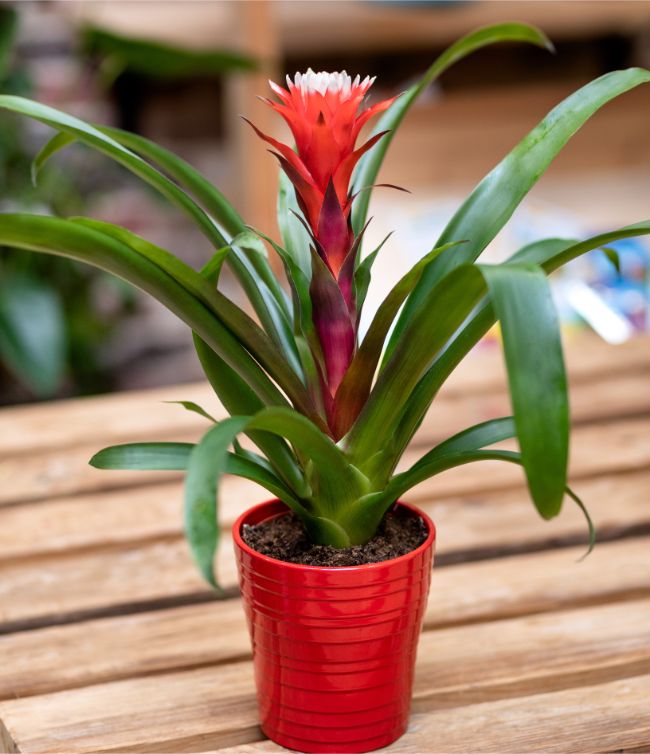
Bromeliad plants are grown for both their gorgeous foliage and the beauty of their flowers if you choose a flowering type. These bold, stylish houseplants work well in a variety of decors ranging from contemporary to tropical styles, adding an exotic touch to your bathroom.
Most bromeliads need a brightly lit spot in your bathroom, out of the direct sun and prefer warmer temperatures (above 75℉) to induce flowering. Keep the growing media moist without overwatering; their short root systems cannot handle too much water.
Bromeliad plants with a central water-holding “vase” need to have the vase constantly filled with water, emptying it every couple of months and then refilling it with clean, fresh water.
Cast-Iron Plant (Aspidistra elatior)
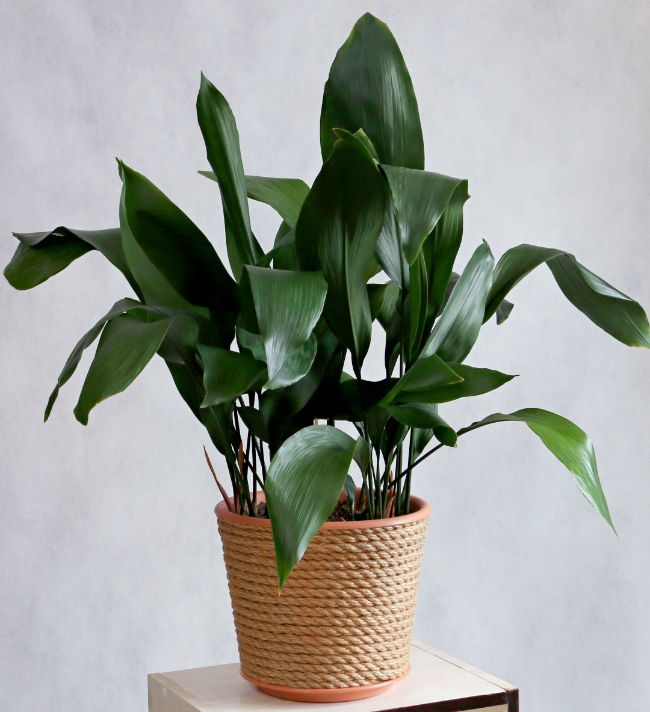
Cast-iron is an almost indestructible substance that can survive a wide range of conditions; this name is fitting for the cast-iron plant as it tolerates low light, low humidity levels, infrequent waterings, and temperature fluctuations.
Cast-iron plants gained popularity in homes during the Victorian Era when living conditions were dark and stuffy – far from the bright, airy homes we have today. Over time they have been edged out in popularity by other houseplants such as peace lilies, snake plants, or philodendrons. However, they still are fantastic options for homeowners and one of the best bathroom plants due to their hardy nature.
Since cast-iron plants can survive a variety of conditions they grow somewhat slowly compared to other houseplants; it will take time for them to mature into their full size of about 3-feet tall. Keep out of direct sunlight to prevent scorching of the leaves that reach 18-inches long.
Allow the soil to dry out between waterings, and water sparingly during the winter months. Avoid the instinct to repot your cast-iron plant frequently. Frequent repotting is one of the plants few dislikes; repot in the spring every 4 or 5 years, dividing plants and replenishing potting soil at that time.
Periodically, tiny purple flowers may bloom at the base of the stems of the cast-iron plant, just above the soil surface.
Read more about how to look after a cast-iron plant in this article.
Chinese Evergreen (Aglaonema spp.)
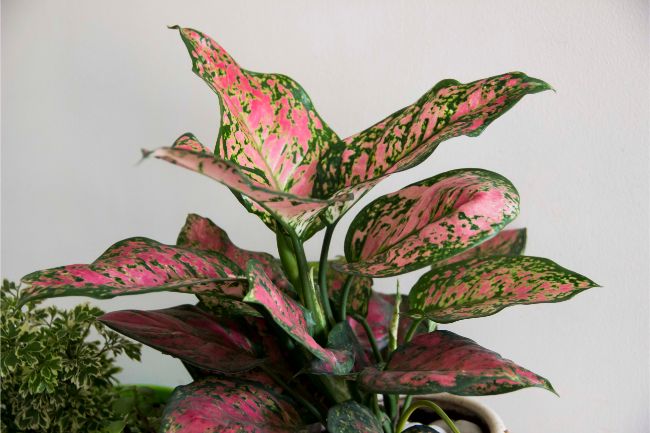
If you’re looking for a low-maintenance plant that can thrive in low light conditions, an Aglaonema, or Chinese evergreen is one that is highly recommended. The dark green foliage of Chinese evergreen comes in a variety of colors to suit any decor: plain green, speckled, blotched, and even variegated types.
Leaves are adorned with silvery accents, reaching a size up to 24 inches long and 3 to 4 inches wide. Mature plants make an attractive statement plant in a corner when they grow upwards of 4-feet tall and wide.
For optimal health, make sure the Chinese evergreen has well-draining potting soil to live in and keep temperatures in the low 70s. They can survive cooler temps but avoid placing them near leaky windows or other cold drafts such as air conditioning vents where it can drop below 50-55℉ to minimize leaf drop. Water plants when the potting soil is dry, and fertilize once or twice a year when the plant is actively growing.
Periodically use a clean, damp cloth to wipe dust from the large foliage to allow your Chinese evergreen to photosynthesize optimally even in low light. Take note too, that over time older, lower leaves may yellow and drop; this is a normal growth habit of the plant and typically doesn’t signify a problem.
Cyclamen (Cyclamen persicum)
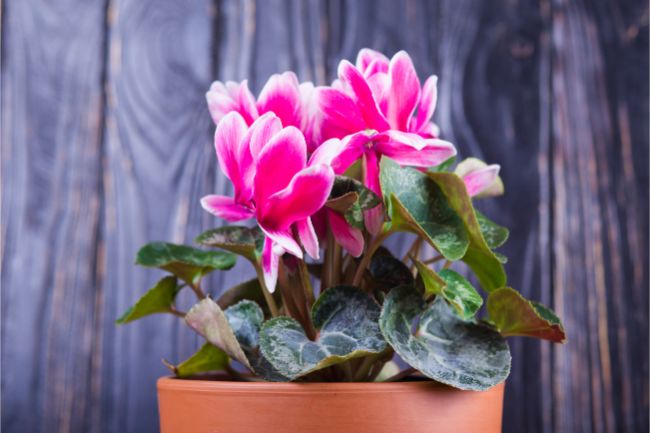
A popular winter-flowering plant, cyclamen are known for their compact growth, beautiful flowers, and decorative foliage. Depending on the variety chosen plants grow from 6 to 12-inches tall, and are adorned with leaves patterned in silver and green.
Blooms can be brightly colored or shades of pastels, and range in size from large, eye-catching displays to small, highly perfumed blossoms.
While plants are in bloom keep the rootball moist without overwatering. Plants benefit from being grown in a well-draining growing media. Water from the bottom, either placing the cyclamen in a sink full of water or keeping it in a tray that can be filled. Cyclamen prefer temps in the low 60s and bright light locations.
Once the plant quits blooming, it will naturally go into a dormant state which unfortunately looks like the plant is dying. With some proper care, you can keep it alive to bloom again in the following years. Allow the leaves to yellow and follow off, removing the foliage as it dies and discontinuing watering.
After the leaves have all died place the plant in a cool, somewhat dark location until the following summer. At that time repot the corm, and move the plant back to a warmer location to bring it out of dormancy.
Dracaena (Dracaena marginata)
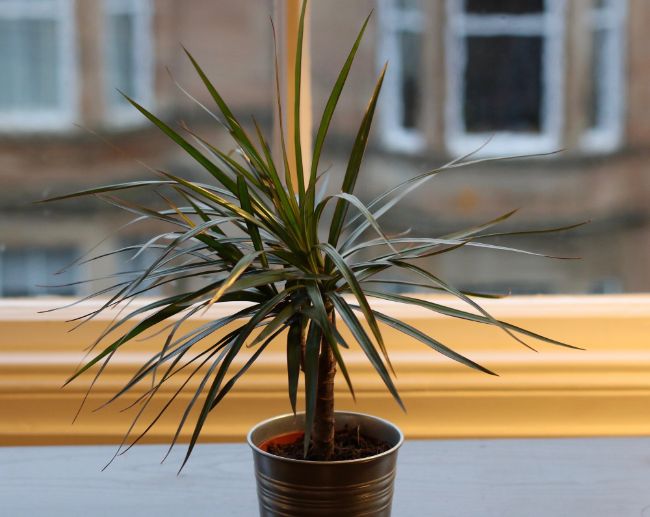
Commonly known as Madagascar dragon tree, Dracaena can grow to a stunning 8 to 15-feet tall and upwards of 8-feet wide! While low light may hinder your plant’s growth, these still make my list as one of the best bathroom plants due to their hardy nature and fantastic looks.
Young plants are small and bushy, with stiff, purplish-red leaves. As plants mature they develop woody stems and become more tree-like.
Keep well-draining potting soil continuously moist, but not overly soggy since a saturated root zone most commonly results in leaf drop or yellowed leaves. Fertilize plants every 2 weeks during the spring and summer, dropping to once a month in the fall, and foregoing fertilization completely during winter months when the plant is dormant.
If your Dracaena is getting too tall for its space prune the top off. New growth will sprout just below the cut in a few weeks and the removed cane can be used to propagate a new plant.
Read my guide to madagascar tree care here.
Dumb Cane (Dieffenbachia seguine)
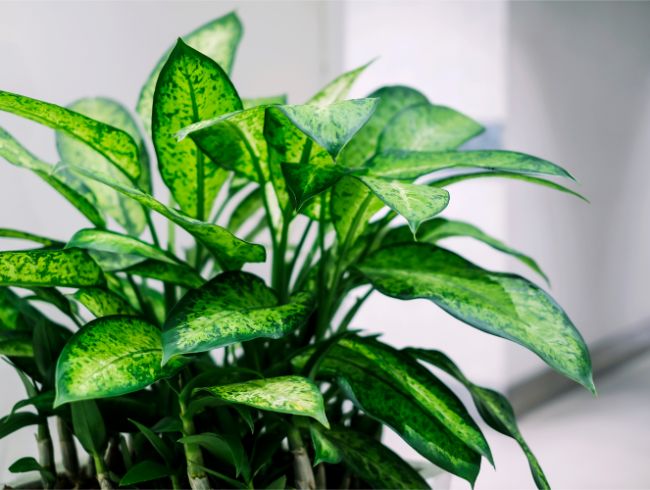
Dumb cane or Dieffenbachia is another beautiful plant incorporated into interior designs either alone or grouped together to create a large, dramatic effect. When mature, the dumb cane plant may reach a height of 5-feet tall with leaves 12-inches long. Shades of cream, yellow, or white mark the leaves, providing a pop of color in dim corners of a bathroom.
Dieffenbachia grows best in filtered light conditions, especially during the spring and summer when plants are putting out new, tender leaves that are incredibly susceptible to sun scorch. Rotate plants often so all sides of the plant receive adequate light and don’t cause uneven growth.
Water when the top 1 to 2-inches of the potting soil is dry to the touch and minimize exposure to cold temperatures or drafts to prevent leaf drop. Fertilize your plant once or twice a year, at a minimum, for optimal health and growth.
This plant is best kept out of the reach of pets and small children. The plant’s milky-white sap can cause temporary swelling of the tongue and throat, rendering a temporary loss of speech. Hence the name dumb cane.
Ferns
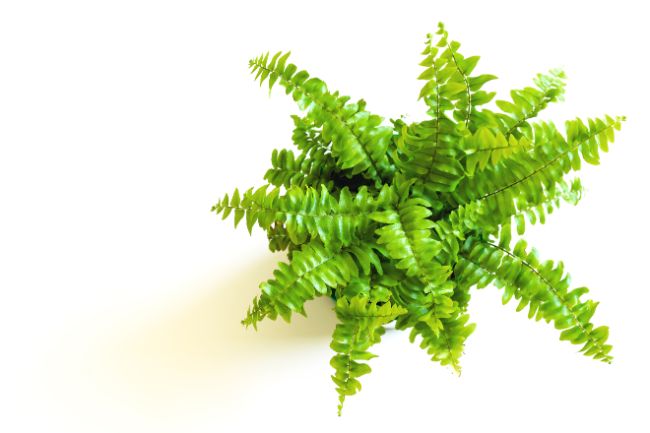
Ferns are another houseplant making a comeback, finding themselves growing in many modern homes. There are over two thousand different varieties that grow indoors, but only a fraction are available commercially for purchase. Some of the most commonly grown ferns are the sword fern, Boston fern, maidenhair fern, bird’s nest fern, and the button fern.
Moist, humid air is critical for growing ferns, which makes them great bathroom plants, as they often struggle in more arid indoor spaces. They thrive in temperatures between 60-70℉ and do best in bright, yet indirect light. Keep their growing media consistently moist and mist fronds regularly.
Aloe Vera
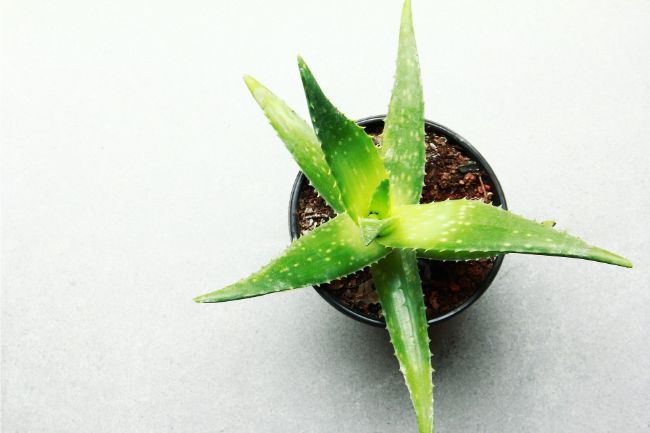
Highly prized for its ability to soothe burns and other skin irritations, aloe vera plants are one of the most commonly indoor-grown succulents worldwide. The aloe plant is even known in some circles as the first-aid plant, burn plant, or a miracle plant.
While most people grow them in the kitchen to use if they burn themselves cooking, aloe plants are good to have in the bathroom too, especially if you are prone to razor bumps or razor burn.
Pot your aloe vera plant in a terracotta container with a well-draining potting soil mix. Terracotta pots allow for better airflow through the container walls helping to dry out the root zone quicker. Their extra weight also keeps the plant from tipping over.
Only water your aloe plant when the potting soil is almost completely dried out. This may mean every couple of weeks during the warmer summer months, and as long as every month or every other month during the winter when the plant is dormant.
Arrowhead Plant (Syngonium podophyllum)
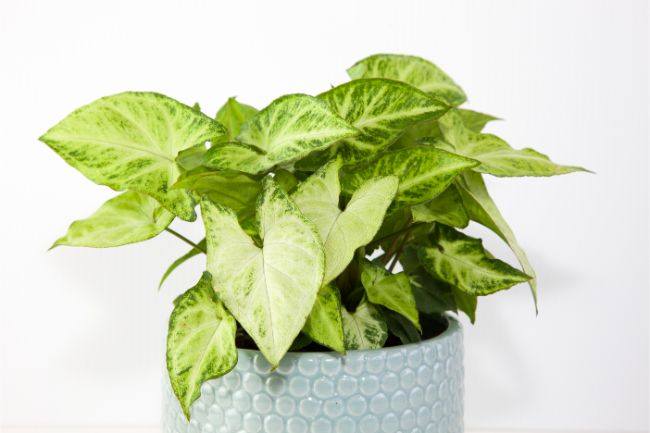
Closely related to the incredibly common philodendron, the arrowhead plant is also known as goosefoot due to its large arrow-shaped leaves. The expansive leaves are available in a variety of color hues ranging from deep, dark green to bronze with many degrees and shades of variegation.
The arrowhead plant needs protection from direct sunlight, making your bathroom an optimal location if it only receives diffuse sun exposure. The warm, moist air from the shower helps the plant to grow vigorously. Maintain temperatures between 60 and 85℉ and water thoroughly when the topsoil becomes dry to the touch.
Trailing vines can be trained to climb up support structures if they are provided. As the plant ages, the notoriously shaped arrowhead leaves mature and morph into a lobed leaf. If the juvenile arrowhead leaf shape is desired cut off the climbing stems when they form to keep the plant from maturing.
Arrowhead plant is mild to moderate in toxicity when ingested by pets so bear this in mind if you have pets who might be prone to have a nibble at your houseplants.
Read my complete guide to growing and caring for your arrowhead plant here.
Gardenia (Gardenia jasminoides)
While many people grow gardenias as shrubs outdoors, with, they make one of the best bathroom plants due to their intoxicating scent. They are more finicky than the other plants on this list, requiring a little extra care and attention, but are well worth it.
Gardenias, like other flowering plants, need a minimum of four hours of light each day, preferring direct sunlight. When they are actively growing keep the growing media moist but not soggy; during the winter months allow the top ½ to 1-inch of potting soil dry out before watering.
They love high humidity levels, making the bathroom a great location. Gardenia plants handle normal indoor temperatures during the day but like it cooler at night, another reason why bathrooms make a great location as they tend to be cooler rooms of a home.
For other amazingly fragrant indoor plants, read this article. If you’d like to read more about growing gardenias indoors, this guide will help.
Grape Ivy (Cissus rhombifolia)
If you’re looking for a low-maintenance vining plant for your bathroom, grape ivy is a good option to consider. A member of the grape family, grape ivy gets its name from the close resemblance it bears to ivies from the Hedera family.
When grown indoors plants can grow up to 3-feet wide, with trailing vines reaching 8 to 10-feet long. They are tolerant of low light conditions, they prefer temperatures below 80°F, and they like their potting soil to dry out slightly before being watered again.
Grape ivy grows well in hanging baskets or tall urns, or when allowed to cascade across the top of cabinets. Pinch back plants periodically to create fuller, bushier growth.
Haworthia (Haworthia spp.)
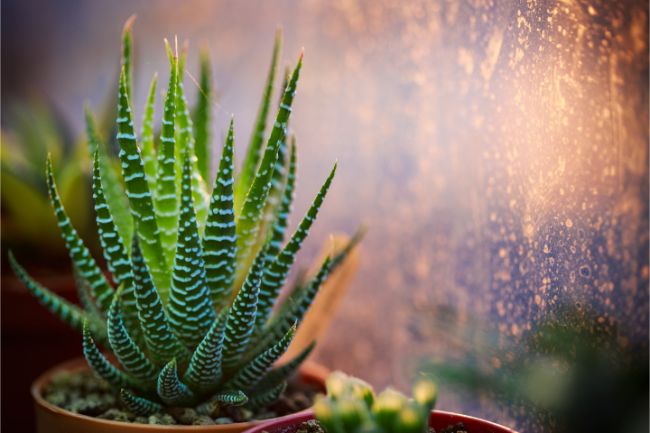
Similar in shape to aloe plants, haworthia is another excellent succulent to put in your bathroom. There are more than 80 species to choose from; the most grown varieties are the pearl plant, zebra haworthia, and the star window plant.
Pearl plants have thick, fleshy leaves and the backs are covered in white tubercles, giving the plant a pearly appearance. On the zebra haworthia, they are arranged in horizontal bands to create a striped appearance. The star window plant has semi-transparent “windows” on the tops of the leaves instead of the white protrusions.
Set haworthia plants in a location where they are out of direct sunlight, but still, get plenty of light. Allow the potting mix to dry out completely between waterings and avoid getting water on the fleshy leaves. Repot every couple of years.
Lucky Bamboo (Dracaena sanderiana)
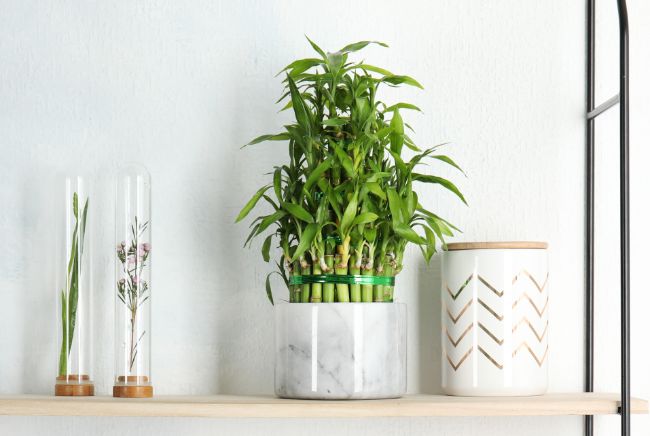
While these aren’t true bamboo plants, but rather a member of the Dracaena family and related to the aforementioned Madagascar dragon tree, lucky bamboo is popular in Asian decor.
They are thought to bring good luck into the surrounding space and their pliable stems are topped off with a flourish of frilly leaves, adding extra flair.
Lucky bamboo are slow-growing and thrive in low light conditions, growing to about 3-feet tall. Keep them out of direct sunlight as it may bleach or scorch the leaves causing irreparable damage.
Lucky bamboo plants are most often grown in water, without any soil, but instead held upright in a container with marbles, stones, or another inert material. Change the water every 2 to 3-weeks to prevent algal growth and fertilize periodically with an aquatic plant food.
Pothos (Epipremnum aureum)
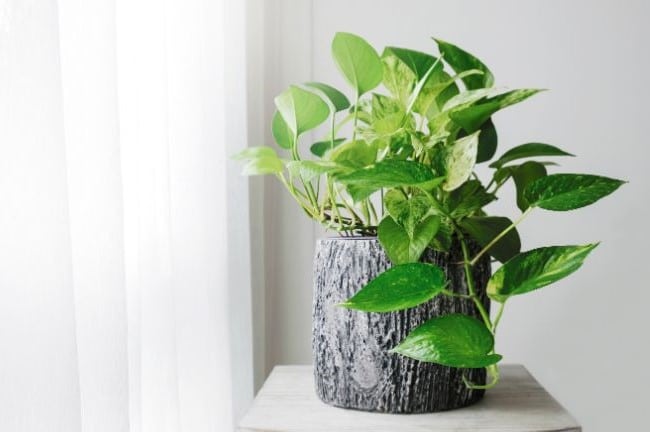
Pothos plants have an incredibly laid back nature, making them one of the easiest and best bathroom plants. They are perfect for beginners as they survive in low light and don’t seem to mind if you miss an occasional watering. They have pointed, heart-shaped leaves that come in shades of green displaying variegations of white, yellow, and pale green.
Plants are typically grown as a trailing vine and can reach 30 feet in length. Water liberally during their active growing season but allow the potting soil to dry out slightly between waterings; repot in the spring as necessary.
People often mistake pothos and philodendron plants for each other as plants as they are incredibly similar in their appearance. Pothos plants tend to have larger leaves than philodendrons and are covered in a waxy coating.
Peace Lily (Spathiphyllum wallisii)
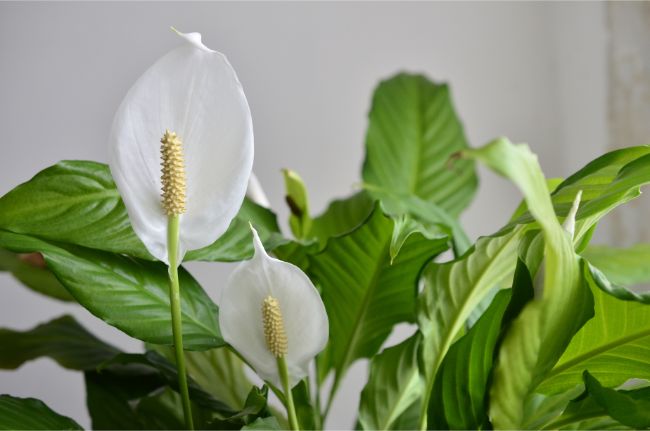
Another favorite houseplant, the peace lily tolerates lower light conditions and produces delicate white flowers in spring and summer. When grown outdoors plants can grow up to 6 feet tall; inside their height is limited to 3 to 4 feet tall if they have good growing conditions.
Peace lilies are great bathroom plants as they love a warm, humid environment. Keep your peace lily away from cold drafts and air conditioning vents, keep the potting soil moist but not soggy, and periodically give your plant fertilizer with a higher phosphorus content to help promote flowering.
Yellowing leaves on your peace lily signify it’s getting too much sunlight or water usually. Brown leaves or leaves with streaks indicate the plant has been exposed to direct light and should be moved to a location where they get diffused sunlight instead.
Read more about how to care for peace lily plants in your home in this article.
Peperomia (Peperomia spp.)
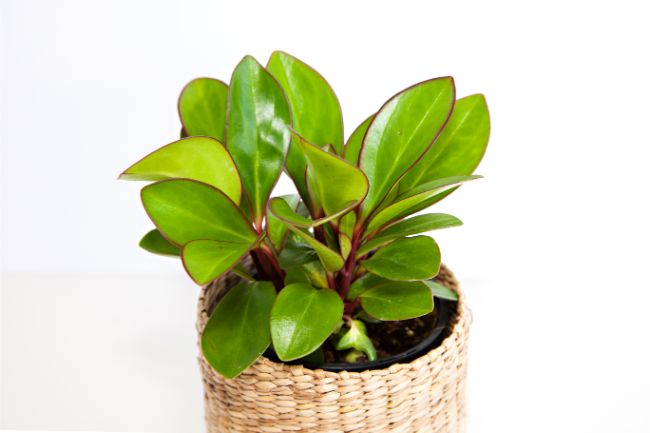
There are dozens of species of Peperomia grown as houseplants due to their compact stature, beautiful foliage and ability to tolerate a wide range of growing conditions. Some of the more commonly grown species are watermelon peperomia, emerald ripple peperomia, baby rubber plant, cupid peperomia, and creeping peperomia.
Place your peperomia plant in a bright spot in the bathroom out of the direct sun to prevent sun scorching of the leaves. Avoid overwatering – the most common reason peperomia plants are killed – by allowing the top 1 to 2-inches of growing media to dry out before giving the plant more water. Peperomia plants have succulent characteristics making them adaptable to low humidity levels but they thrive in bathrooms where the air is moister.
Find out more about the wonderful variety of peperomia plants and how to care for them.
Philodendron (Philodendron spp.)
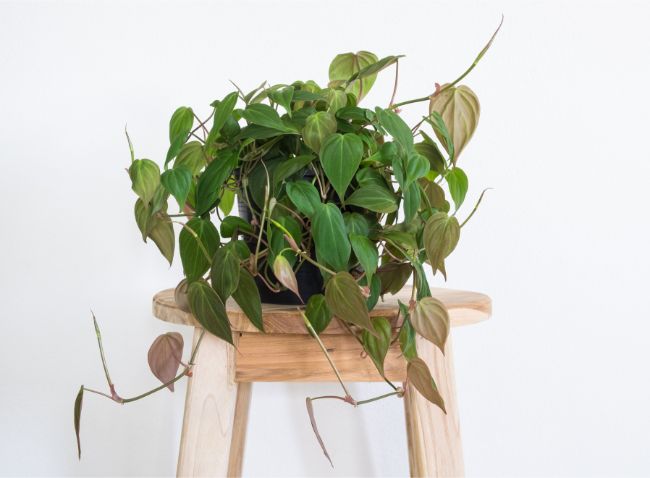
The philodendron is another popular, classic houseplant that comes highly recommended to even those with the blackest of thumbs. Caring for them is incredibly simple as plants adapt to a wide range of growing conditions.
Philodendron plants are either a climbing/vining variety or a self-heading (non-climbing) type. The vining types are commonly grown in hanging baskets or are trained to grow up some sort of support structure. The non-climbing types have an upright, spreading growth habit and need plenty of room as they’ll grow twice as wide as they are tall.
Set your philodendron is a spot that receives plenty of bright, indirect light. Too little light results in plants that are leggy with several inches between the leaves. Too much light will cause numerous leaves to yellow simultaneously. Water when the top 1-inch of the potting soil is dry to prevent overwatering.
Pitcher Plant (Sarracenia spp.)
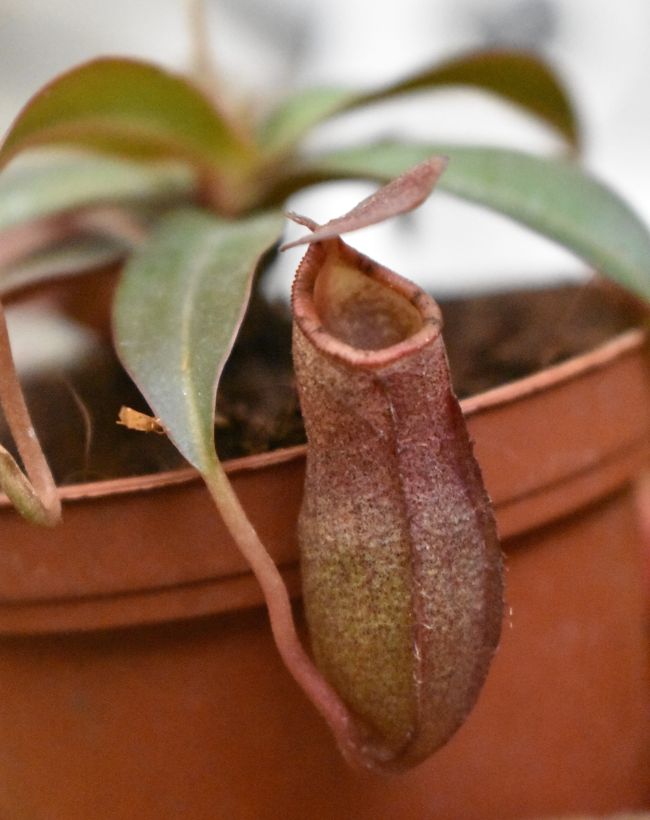
The only carnivorous plant to make the list, the pitcher plant is a unique houseplant to add to your bathroom’s decor. Their modified leaves look like tubes and are known as pitfall traps – a deep cavity filled with digestive liquid.
Pitcher plants have their unique shape because of nitrogen deficiencies in the soil. So when growing them indoors they do better in low-fertility growing substrates; a mix of peat moss, bark, and vermiculite is perfect for them. When grown indoors, keep the growing substrate consistently moist and fertilize plants with a high-quality orchid food monthly during the active growing season.
Snake Plant (Sansevieria trifasciata)
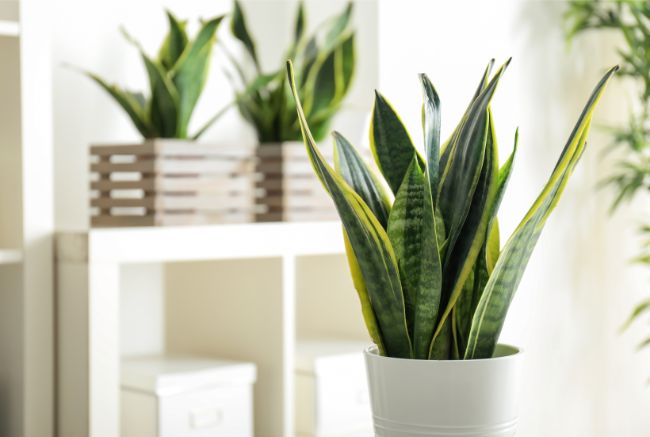
Another one of the most commonly grown houseplants, the snake plant, or mother-in-law’s tongue is great for bathrooms where there isn’t a lot of natural sun exposure. Its striking appearance and low maintenance needs make it a great addition to a bathroom.
The snake plant’s swordlike leaves grow to 3 feet in height or more, coming in a variety of shapes: short and wide, narrow and long, and even cylindrical to give the plant a spike-like appearance. Leaves come in a wide range of colors from white to yellow, green-striped, and green leaves cross-banded with distinct golden edges.
Snake plants are easy to care for withstanding periods of drought, growing in bright sunshine or shade, and rarely needing to be repotting. Be cautious to not overwater a snake plant as it is very susceptible to root rot.
Spider Plant (Chlorophytum comosum)
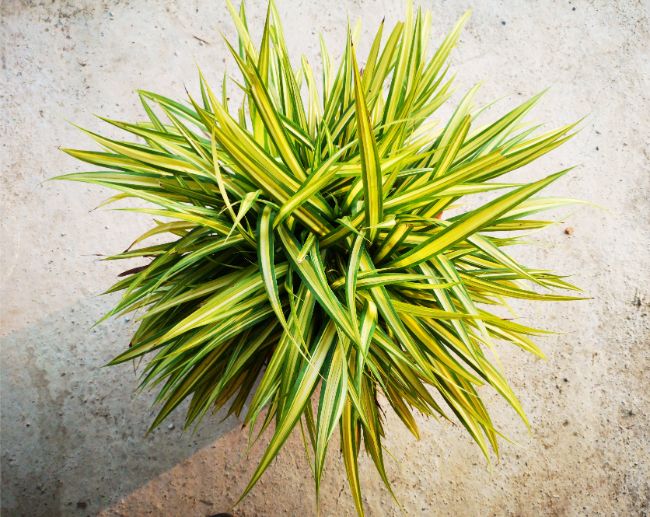
Another classic and dependable bathroom houseplant, the spider plant is a great option for hanging baskets or to set on top of a cabinet or plant stand in your bathroom. The spider plant will grow in a range of conditions and suffers from very few problems other than brown tips that arise from dry air. Naturally higher humidity in the bathroom can prevent tips from browning, keeping the plant looking its best.
Spider plants are also known as the airplane plant as they produce baby plants, or spiderettes in the spring and summer following flowering. The tiny plantlets dangle down beneath the long, slender, arching leaves of the mother plant looking like spiders on a web. These babies can be left growing on the plant to create an attractive display or they can be removed and potted to propagate new plants.
Asparagus Fern (Asparagus densiflorus)
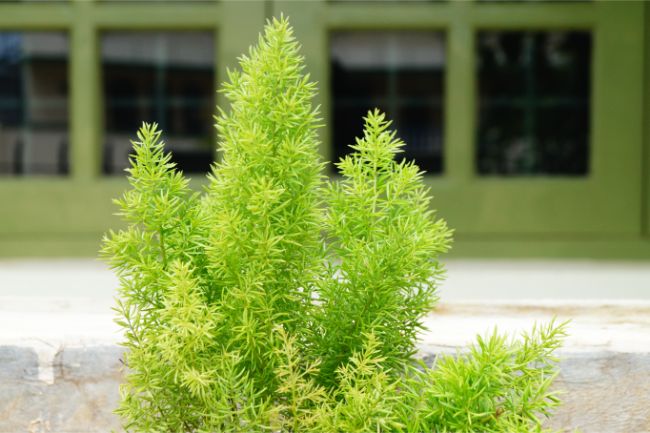
Contrary to the name, asparagus fern isn’t related to asparagus, nor is it a true fern but it still is an excellent plant to put in your bathroom if it has low light. Asparagus ferns are a member of the lily family and have long, arching stems or branches densely covered in short needle-like leaflets.
When fully mature plants can reach 3 to 4-feet in width; their cascading stems grow to a length of 3-feet making the asparagus fern a perfect plant for a hanging basket.
Keep your plant pruned to maintain a pleasing shape but watch out for thorns on the stems when pruning. Water when the soil begins to dry out and periodically mist the foliage with room temperature water to keep the humidity high around the leaves. Asparagus ferns will drop its small leaflets is the air inside your home is too dry.
Beware though, this lacy, delicate-looking houseplant bears thorns on its stems and is toxic to both dogs and cats.
Weeping Fig (Ficus benjamina)
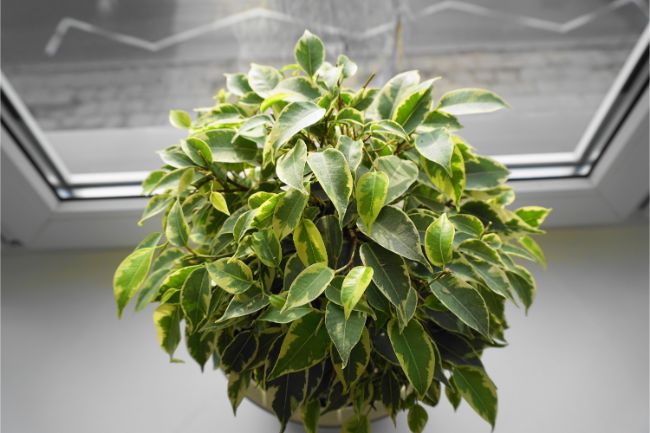
Weeping fig plants are a member of the popular ficus family and are more tree-like than other ficus species. They get their name from the characteristic narrow, arrow-like leaves that line delicate woody stems. Weeping figs are commonly found gracing many a doctor’s or dentist’s office and the hallways of shopping malls because of their stately nature.
One of the most important parts of successfully growing weeping fig indoors is determining a proper watering schedule. This can be a tricky task, resulting in leaf drop if not done properly as both too little water and too much water will cause the leaves to fall off the plant.
The best thing to do is to maintain a consistent, even watering schedule during the warmer months when the weeping fig is actively growing and a reduced, albeit still consistent, schedule in the cooler winter months when the plant’s growth slows.
I’ve written a complete guide to weeping fig care to help you get the most from your plant.

